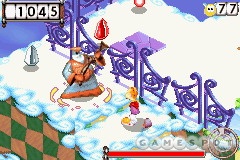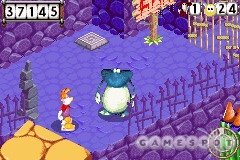People familiar with Rayman's earlier adventures on the Game Boy Advance are in for a surprise with Rayman: Hoodlums' Revenge. The levels in this latest installment are isometric instead of side-scrolling. As a result of that one change alone, this new game looks and plays quite differently than other Rayman games have. Whether that's a good thing or a bad thing will depend mainly on your own personal tastes, but compared to other isometric platformers at least, Rayman: Hoodlums' Revenge serves up a good mix of platform-jumping, puzzles, and fisticuffs.

As the title implies, Hoodlums' Revenge is a follow-up to Rayman 3: Hoodlum Havoc. The story revolves around the misdeeds of a dark lum named Andre, who Rayman's companion Globox has, once again, accidentally swallowed. Using Globox's body, Andre unleashes a horde of monsters and locks up all of the friendly teensies that normally keep the forest green and healthy. Upon learning of this chain of events, Rayman embarks on a quest to free the teensies and rescue his pal from the dark lum's control.
If you've played other isometric platformers, specifically the Spyro series, you know what to expect here. The general goal of each level is to reach the exit. Along the way, you'll have to jump between small islands, open doors by activating the appropriate switches, and deal with the various enemies strewn here and there. Using the directional pad and buttons, you can have Rayman walk around, jump, and punch. Hold the buttons longer and you can make him float or cast out his fist, which is especially useful against distant enemies. The different enemies can attack Rayman in one of two ways: either by stabbing him with swords or by tossing grenades. Most attacks don't do much damage at all. Plus, there are always plenty of health lums scattered around that will replenish Rayman's health indicator. The real danger to watch out for is the water that sits between most platforms. Rayman can't swim, so contact with water will rapidly deplete his health. Thankfully, the game offers unlimited continues, which means that the worst thing that will happen if you let Rayman drown is that you'll have to start the level over from the last checkpoint.
Previous Rayman games were typical 2D platformer fare--with emphasis placed on actions such as jumping, rope swinging, and ladder climbing. Hoodlums' Revenge is different, probably because of the limitations inherent to the isometric viewpoint. There's still a lot of platform-jumping, but, for the most part, the tasks put to the player in each level involve punching out enemies and finding the solutions to switch-based puzzles. Some of the game's 20 levels put the player in control of Globox, who, unlike Rayman, can't jump and can't get near enemies unless first loading up on prune juice. The prune juice brings out the dark lum's evil nature, which in turn gives Globox the courage to walk up to enemies and beat them senseless. In other levels, you'll have to alternate control between Rayman and Globox. Each character can do things the other can't. Rayman can climb up certain walls and his insubstantial weight allows him to ride in boats. Meanwhile, Globox is so heavy that he can activate large switches that Rayman can't. Globox also doesn't have a health indicator, which means you don't have to worry about taking damage or falling into water while controlling him. As you can imagine, the basic idea here is that you're supposed to continually switch between the characters until one of them is able to reach the exit.
Fans acquainted with Rayman's earlier outings on the GBA can at least rest easy knowing that this new game won't hurt the franchise's reputation for high-quality graphics and audio. From a technical standpoint, the backgrounds are colorful and sharp, and the developer has done a good job of orienting objects and surfaces in the environment so that they enhance the illusion of 3D that the isometric tilt establishes. Artistically, Rayman's world looks puffy and surreal. The fluffy clouds, pink trees, candy turrets, and lime green rivers look like the sorts of things you'd read about in a Dr. Seuss book. You'd expect nothing less from a game where the main character has hands and feet, but no corresponding arms or legs, and where his sidekick resembles a cross between Barney the dinosaur and the Grimace. Overall, there are loads of different enemies, and the animation for all of the characters is fairly smooth. Most of the character sprites and many of the objects in the background were made from prerendered computer models, which also contributes to the 3D effect. Meanwhile, the music and sound effects suit the settings and goings-on nicely. Each level has its own unique theme, typically something light and whimsical, and the sound effects consist of a healthy mixture of artificially generated noises and recorded speech.
The game's biggest flaws are the same ones that seem to dog every action game that employs the isometric perspective. First off, the tilt that gives the background its three-dimensional look also sometimes makes it difficult to judge the distance between platforms or to see where Rayman's feet are in relation to the ground. That can be frustrating, especially since falling into the water has such dire consequences. Another drawback is that the levels are expansive but they don't really feature much in the way of interactivity aside from switches, boats, and scalable walls. The isometric graphics put too much of a strain on the GBA's processor to allow things like rope swings or trampolines, which are trademark features of the 2D Rayman games.

Certainly, the lack of interactive environmental features combined with the expansiveness of the game's levels could lead to burnout after a while. The ability to swap between Rayman and Globox in some levels alleviates that possibility somewhat. As do the practical rewards that the developer built in as an incentive for playing through and replaying levels--namely, bonus levels that can be unlocked based upon the high scores you get and the items you manage to collect in each level.
All told, Rayman: Hoodlums' Revenge will probably satisfy anyone that has enjoyed other isometric-style platformers in the past.